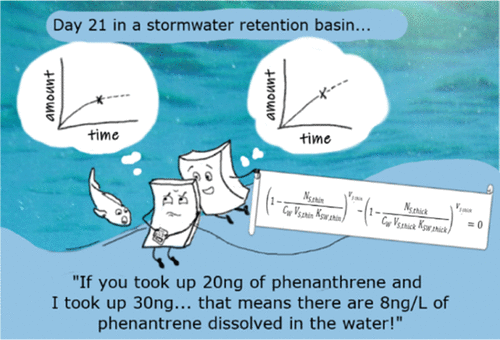当前位置:
X-MOL 学术
›
Environ. Sci. Technol.
›
论文详情
Our official English website, www.x-mol.net, welcomes your
feedback! (Note: you will need to create a separate account there.)
Kinetic Passive Sampling: In Situ Calibration Using the Contaminant Mass Measured in Parallel Samplers with Different Thicknesses
Environmental Science & Technology ( IF 10.8 ) Pub Date : 2020-11-19 , DOI: 10.1021/acs.est.0c04437 Hanna E. Fuchte 1 , Andreas Schäffer 1, 2 , Kees Booij 3 , Kilian E. C. Smith 1
Environmental Science & Technology ( IF 10.8 ) Pub Date : 2020-11-19 , DOI: 10.1021/acs.est.0c04437 Hanna E. Fuchte 1 , Andreas Schäffer 1, 2 , Kees Booij 3 , Kilian E. C. Smith 1
Affiliation

|
The use of single-phase passive samplers is a common method for sampling bioavailable concentrations of hydrophobic aquatic pollutants. Often such samplers are used in the kinetic stage, and in situ calibration is necessary. Most commonly, exchange kinetics are derived from the release rates of performance reference compounds (PRCs). In this study, a complementary calibration approach was developed, in which measuring the contaminant mass ratio (CMR) from two samplers with different thicknesses allows the dissolved concentrations to be determined. This new CMR calibration was tested (1) in a laboratory experiment with defined and constant concentrations and (2) in the field, at a storm water retention site. Silicone passive samplers with different thicknesses were used to sample a range of dissolved polycyclic aromatic hydrocarbons. In the laboratory study, the concentrations derived from the CMR calibration were compared with those from water extraction and passive dosing and differences below a factor 2 were found. In the field study, CMR-derived concentrations were compared to those from PRC calibration. Here, differences ranged by only a factor 1 to 3 between both methods. These findings indicate that the CMR calibration can be applied as a stand-alone or complementary calibration method for kinetic passive sampling.
中文翻译:

动态被动采样:使用在不同厚度的平行采样器中测量的污染物质量进行原位校准
使用单相无源采样器是对生物可利用浓度的疏水性水生污染物进行采样的常用方法。通常在动力学阶段使用此类采样器,并且需要现场校准。最常见的是,交换动力学源自功能参考化合物(PRC)的释放速率。在这项研究中,开发了一种互补的校准方法,其中通过测量来自两个具有不同厚度的采样器的污染物质量比(CMR),可以确定溶解浓度。这项新的CMR标定已在(1)实验室实验中以规定的浓度和恒定的浓度进行了测试,并且(2)在雨水保留地点的现场进行了测试。使用具有不同厚度的有机硅无源采样器来采样一系列溶解的多环芳烃。在实验室研究中,将CMR校准得出的浓度与水提取和被动加药得出的浓度进行了比较,发现差异小于2倍。在现场研究中,将CMR衍生的浓度与PRC校准的浓度进行了比较。在此,两种方法之间的差异范围仅是1到3。这些发现表明,CMR校准可用作动力学被动采样的独立或补充校准方法。
更新日期:2020-12-15
中文翻译:

动态被动采样:使用在不同厚度的平行采样器中测量的污染物质量进行原位校准
使用单相无源采样器是对生物可利用浓度的疏水性水生污染物进行采样的常用方法。通常在动力学阶段使用此类采样器,并且需要现场校准。最常见的是,交换动力学源自功能参考化合物(PRC)的释放速率。在这项研究中,开发了一种互补的校准方法,其中通过测量来自两个具有不同厚度的采样器的污染物质量比(CMR),可以确定溶解浓度。这项新的CMR标定已在(1)实验室实验中以规定的浓度和恒定的浓度进行了测试,并且(2)在雨水保留地点的现场进行了测试。使用具有不同厚度的有机硅无源采样器来采样一系列溶解的多环芳烃。在实验室研究中,将CMR校准得出的浓度与水提取和被动加药得出的浓度进行了比较,发现差异小于2倍。在现场研究中,将CMR衍生的浓度与PRC校准的浓度进行了比较。在此,两种方法之间的差异范围仅是1到3。这些发现表明,CMR校准可用作动力学被动采样的独立或补充校准方法。









































 京公网安备 11010802027423号
京公网安备 11010802027423号